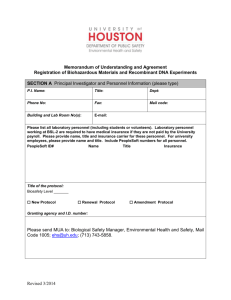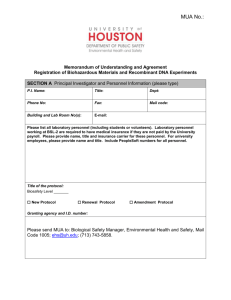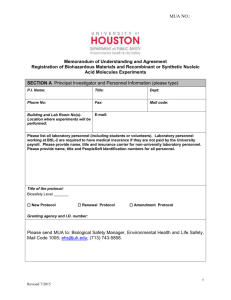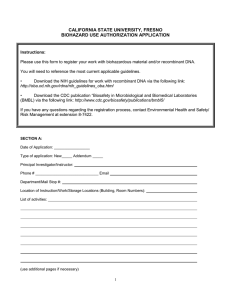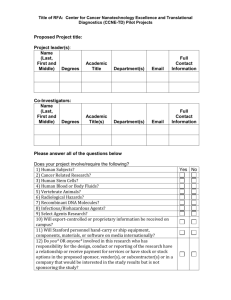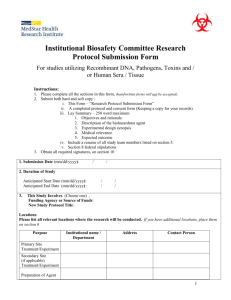P - Texas State University
advertisement
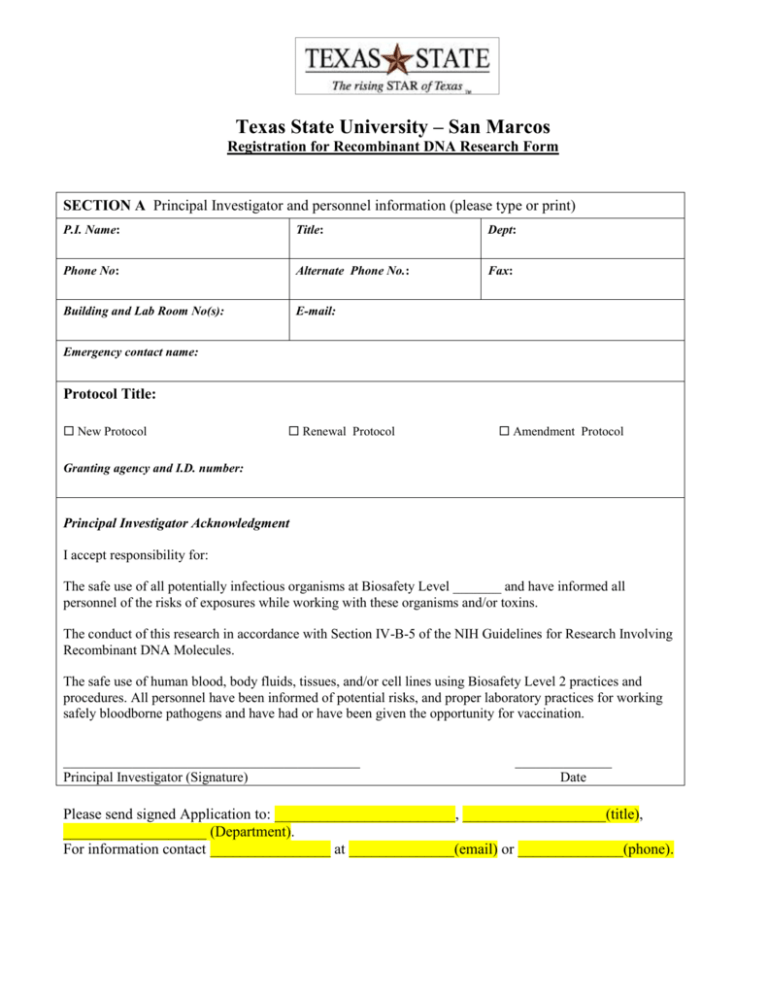
Texas State University – San Marcos Registration for Recombinant DNA Research Form SECTION A Principal Investigator and personnel information (please type or print) P.I. Name: Title: Dept: Phone No: Alternate Phone No.: Fax: Building and Lab Room No(s): E-mail: Emergency contact name: Protocol Title: New Protocol Renewal Protocol Amendment Protocol Granting agency and I.D. number: Principal Investigator Acknowledgment I accept responsibility for: The safe use of all potentially infectious organisms at Biosafety Level _______ and have informed all personnel of the risks of exposures while working with these organisms and/or toxins. The conduct of this research in accordance with Section IV-B-5 of the NIH Guidelines for Research Involving Recombinant DNA Molecules. The safe use of human blood, body fluids, tissues, and/or cell lines using Biosafety Level 2 practices and procedures. All personnel have been informed of potential risks, and proper laboratory practices for working safely bloodborne pathogens and have had or have been given the opportunity for vaccination. ___________________________________________ Principal Investigator (Signature) ______________ Date Please send signed Application to: ________________________, ___________________(title), ___________________ (Department). For information contact ________________ at ______________(email) or ______________(phone). For purposes of this registration, biohazardous materials are defined as any organism known to or suspected of causing infection in humans, and a toxin is a proteinaceous poison which is highly toxic to humans. Experiments using biohazardous materials and toxins should follow the CDC/NIH Biosafety in Microbiological and Biomedical Laboratories (BMBL) Guidelines (4th Edition-1999). Experiments using recombinant DNA technology should follow the NIH Guidelines for Research Involving Recombinant DNA (rDNA) Molecules, (April 2002). The Principal Investigator (PI) is responsible for completing the appropriate parts of this registration document. The Texas State University Institutional Biosafety Committee (IBC), in conjunction with the Environmental Health, Safety and Risk Management Department (EHS & RM), maintains a registry of all laboratories and personnel working with human pathogens, and/or toxins, human blood, body fluids, and tissues, and recombinant DNA technology. The PI is also responsible for notifying EHS & RM when work with any potentially infectious material is terminated or when other significant changes occur, such as changes in protocol, personnel or relocation of the laboratory. This registration document is to be forwarded to EHS & RM (EHS Specialist) prior to the initiation of work. Each individual listed should be informed of the potential hazards associated with this work, the appropriate safety practices to be used, the availability of medical programs, and applicable training requirements. EHS & RM conducts an annual survey of registered laboratories to review practices and procedures. The survey is not intended to negate the responsibilities of the PI in supervising work with potentially infectious or hazardous materials. RISK GROUPS AND BIOSAFETY LEVELS should be determined using the BMBL and the NIH rDNA Guidelines. Additional information for infectious agents can be found in the American Biological Safety Association (ABSA) website (http://www.absa.org/resriskgroup.html) SECTION B Brief description of the research understandable to scientist working in different fields New Protocol Renewal Protocol Amendment Protocol Title of the protocol: __________________________________________________________________________ This project will use: Biohazardous Material Biological Toxins Recombinant DNA B.1. Provide the date when you propose to begin research and the date when you anticipate research will be completed: B.1.a. Proposed Start date: B.1.b. Anticipated completion date: B.2. General description of research: B.3. Hypothesis: B.4. Types of biological agents and toxins, their quantity, duration of experiment, and/or the rDNA technology to be applied: -2- B.5. Significance of the project B.6. Please include any additional information that may assist the IBC in the review of this protocol (e.g. description of experimental design, procedures, etc) SECTION C Use of recombinant DNA technology Prokaryotic Hosts/ Eukaryotic Cells List Strains Vector DNA Insert Not Applicable Relevant section of NIH Guidelines No If viral vector is to be used will infectious virus be generated? Physical Containments Yes Will studies include attempts to obtain expression of a foreign gene, other than those used for selection purposes? No Yes what protein _____________________________ SECTION D Potential human pathogens and/or toxins (please provide information for each microorganism and or toxin used, use additional space if needed) Not Applicable Organism: Strain: Biological Toxins: Volume used: Risk group: Volume used: Risk group: Is organism concentrated? Specify methods: centrifugation No filtration Yes Precipitation Containment equipment available: Biological Safety Cabinet: Fume Hood Class__________________ Containment Centrifuge Other ___________________________ Last Certified:_______________________ Other ___________________________ -3- SECTION E Use of animals Are animals used in this project? List all animals used in the project No Yes Date IACUC Approval (if applicable) ________________ Organism, toxin, or rDNA introduced Routes of administration Types of animal tissue handled and/or animal cell lines SECTION F Handling of Human Products (requires BSL-2 practices) Are Human samples used in this project? No Type of human samples manipulated Cell lines Blood Tissues Other ___________________ Urine Spinal Fluid Serum Feces Semen Specify______________________________________________________ Type of manipulations: Centrifugation Bleeding/Mixing Other ___________________ Yes Date IRB Approval (if Applicable) ________________ Dissection Sonication Pipetting SECTION G Safety, Security, and Training Plan - Use the BMBL as a guide only to write your specific safety procedures. Follow the outline below for the items that are applicable to your project (please put NA in all the rest). If you are working with animals describe in detail the safety protocol for handling infected animals in the animal care facility G.1. Training Plan: G.2. Security Plan: G.2.a. Access to the laboratory: G.2.b. Access to the biological agents: G.3. Safety Plan: G.3.a. Specific Laboratory Practices: G.3.b. Personal Protective Equipment Required: G.3.c. Containment and Safety Equipment Used: G.3.d. Decontamination and Spill Clean-up Procedures: G.3.e. Transfer and/or Transport of Biohazards Between/Outside the Laboratories: G.3.f. Handling of Hazardous Waste: G.3.g. Medical Surveillance: H. Special Safety Practices in the Animal Care Facility: -4- Will ship or transport biohazardous material Will generate biohazardous waste No No Yes Yes The following websites contain information that can help you complete the Registration for Recombinant DNA Research Form http://www.cdc.gov/od/ohs/biosfty/bmbl/bmbl3toc.htm CDC - Biosafety in Microbiological and Biomedical Laboratories (BMBL) http://www4.od.nih.gov/oba/rac/guidelines/guidelines.html NIH guidelines for work with recombinant DNA molecules http://www.absa.org/resriskgroup.html ABSA - American Biological Safety Association Risk Group classification tables http://www.who.int/csr/resources/publications/biosafety/en/Biosafety7.pdf WHO 2004 Laboratory Biosafety Manual -5-
